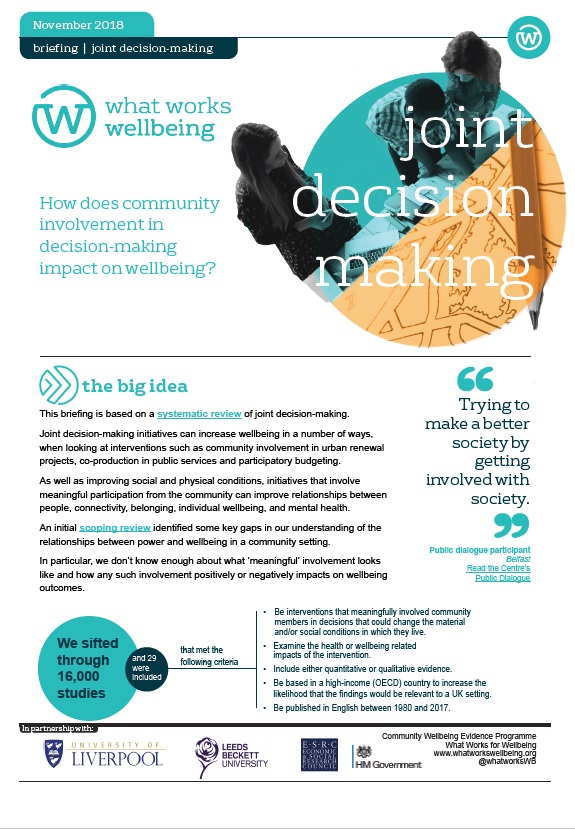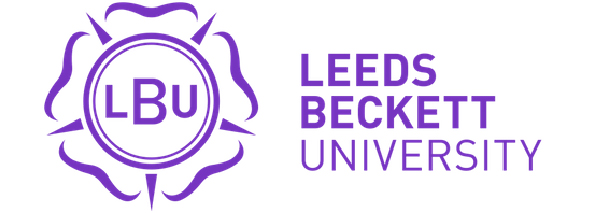Joint Decision Making
Downloads

Intro
Joint decision-making initiatives can increase wellbeing in a number of ways, when looking at interventions such as community involvement in urban renewal projects, co-production in public services and participatory budgeting.
As well as improving social and physical conditions, initiatives that involve meaningful participation from the community can improve relationships between people, connectivity, belonging, individual wellbeing, and mental health.
An initial scoping review identified some key gaps in our understanding of the relationships between power and wellbeing in a community setting.
In particular, we don’t know enough about what ‘meaningful’ involvement looks like and how any such involvement positively or negatively impacts on wellbeing outcomes.
Trying to make a better society by getting involved with society.
What are the key findings?
Where you see the following symbols it indicates:
-
qualitative
-
quantitative
-
strongWe can be confident that the evidence can be used to inform decisions.
-
promisingWe have moderate confidence. Decision makers may wish to incorporate further information to inform decisions.
-
initialWe have low confidence. Decision makers may wish to incorporate further information to inform decisions.
Strong, promising and initial evidence refer to high, moderate and low quality evidence / confidence as per GRADE and CERQual guidance. For further information on these classifications, please see the Centre’s Methods Guide.
All evidence should be considered alongside questions of possible benefits and risks, affordability, acceptability, feasibility and wider impacts, including equity issues, in the user setting. Where the evidence is less strong, these other considerations become even more important.
May improve the wellbeing of those participating in decision-making, and the wellbeing of the wider community. It may also lead to greater improvements in
the physical environment in which people live, enhanced social connections, improved sense of community, reduced social isolation, improved (individual) physical health, and improvements to individual wellbeing such as reductions in levels of depression.
May improve the wellbeing of those participating in decision-making, and the wellbeing of the wider community. Community involvement may improve local services, social relations, confidence and skills, and participants sense of pride in and belonging to their community.
Involving communities in decision about how local public budgets are spent may improve the wellbeing of those participating in decision-making, and the wellbeing of the wider community. It can enhance peoples’ trust in local authorities and their
sense of belonging to their community. It may improve social determinants of health, social relations within communities, and relationships between the community and public agencies.
Community members working together – along with local authorities; voluntary, community and social enterprise organisations; and private businesses – to save and enhance community facilities may benefit their health and the health of the wider community. This may enhance social determinants of health, improve social relationships within the community, and improve individual and community wellbeing by reducing isolation and building social networks.
May improve the wellbeing of those participating in decision-making, and the wellbeing of the wider community. It may improve social determinants of health, and the wellbeing of individuals, for example, levels of satisfaction or trust.
How does it help you?
Policy makers can remove barriers and provide assistance that enable and empower communities in decision-making, for them to initiate, design and deliver change for the benefit of community wellbeing.
Deliberate meaningful involvement can maximise the beneficial wellbeing impacts of community decisions and minimise any adverse impacts and inequalities resulting from ineffective involvement.
1. Communicate clearly and transparently
Create clear and transparent arrangements for partnership working.
Be open and realistic about what can and cannot be achieved, and about how long delivery may take.
Carry out good communication and monitoring, and provide feedback to participants on what has and has not been delivered. Share learning and examples of best practice.
2. Provide training and support
Provide training and ongoing support to community participants and staff from public agencies engaged in joint decision-making.
3. Develop organisational culture and commitment to empowering communities
Promote full commitment to partnership working at all levels of organisations and make it a responsibility for all.
Allow the community participants greater control over the ‘rules’ and processes of participation.
Trust the process of involvement and the ability of participants, and be prepared to relinquish control to communities.
Deliver the plans that communities help to develop.
4. Timing and accessibility of involvement
Involve communities from the start, so they are involved in all key decisions and to promote a sense of ownership.
Maintain involvement of both communities and public agencies throughout.
Identify and address barriers to communication and involvement for all participants (e.g. physical barriers; financial barriers; literacy, numeracy and language barriers; cultural barriers; barriers relating to caring responsibilities and time/availability to participate).
Allow community participants greater flexibility to engage.
5. Capturing learning from joint decision-making processes
There should be monitoring, measurement and evaluation of projects to include people’s experiences of the processes of joint decision making, as well as the health and wellbeing outcomes.
This will ensure that we cement learning and build a knowledge base of best practice in this area.
What can you do next? (Evidence Call)
What’s happening?
The Community Wellbeing Evidence Programme, with the University of Liverpool, are carrying out a systematic review that is trying to locate evidence on the impacts of interventions that involve joint decision-making in communities.
What are they looking for?
The review team are interested in how interventions involving joint decision-making in communities impact on individual and community wellbeing. Interventions may include policies, plans, programmes or projects that are delivered within local communities. Impacts on wellbeing include (‘determinants’) the local physical and social conditions in which people live; and impacts on people’s health and wellbeing (‘outcomes’). Examples include effects on the provision and quality of local services, or the local built and natural environment; and people’s satisfaction with their local services, their local area, or their perceptions of their own health and wellbeing.
Explore more
![]()
[gravityform id=1 title=true description=true ajax=true tabindex=49]



